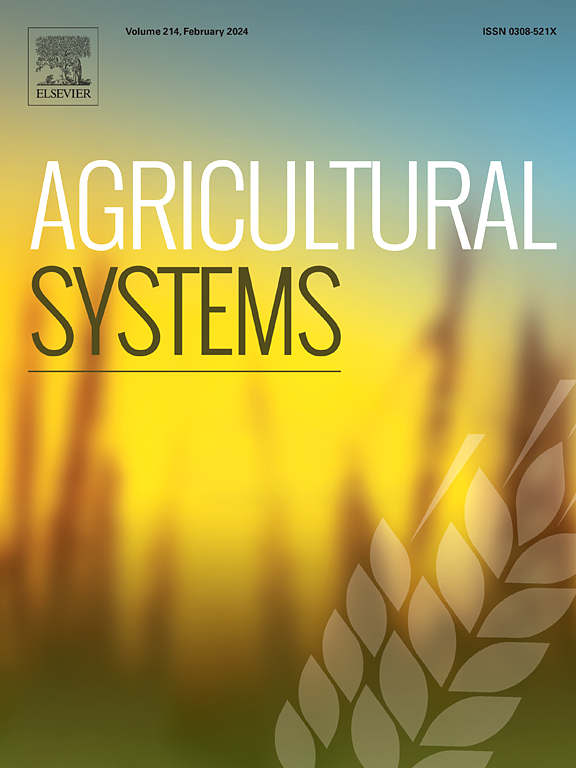Assessing the adaptability of agronomic landscape to climate change at watershed scale
IF 6.1
1区 农林科学
Q1 AGRICULTURE, MULTIDISCIPLINARY
引用次数: 0
Abstract
CONTEXT
A region's agricultural practices, particularly farmers' choices regarding plowing and planting, influence the adaptability of croplands to climate change. However, the role of these agronomic landscapes in mediating cropland responses to diverse climate conditions remains unclear.
OBJECTIVE
This study evaluates a typical watershed in Northeast China. We continuously tracked shifts in crop distribution patterns and associated field yield to determine how agronomic landscapes impacted cropland productivity during both dry and wet years.
METHODS
Object-oriented methods were employed to extract field boundaries in a representative sub-watershed. We mapped agronomic landscape patterns based on the following elements: crop type, landscape position, and ridge direction. We then compared field productivity, as measured by the Normalized Difference Vegetation Index (NDVI), across various agronomic landscapes and climatic years from 2016 to 2023.
RESULTS AND CONCLUSIONS
Our findings indicate that cropland productivity is associated with agronomic landscapes. Maize productivity demonstrated an increasing trend from low to high landscape positions; whereas, soybean productivity peaked at medium positions and was lowest in uphill and downhill locations. Specifically, agronomic landscapes reflected by cross ridges at the toeslope exhibited the lowest productivity for both maize and soybeans. In addition, landscapes incorporating soybeans demonstrated greater adaptability to varying weather conditions compared to those dominated by maize. During wet years, landscapes with maize situated in the footslope with strike ridges exhibited higher productivity. In contrast, landscapes incorporating soybeans displayed robust productivity across most landscape positions, particularly in the toeslope with strike ridges. During dry years, landscapes featuring maize in both the footslope with strike ridges and the toeslope with cross ridges demonstrated greater productivity. Similarly, landscapes with soybeans distributed throughout the watershed, especially in the footslope with cross ridges and toeslope with strike ridges, exhibited higher yields.
SIGNIFICANCE
Our findings highlight the crucial role of optimizing agronomic landscapes to enhance the climate resilience of croplands and ensure stable yields. It is thus suggested that the implementation of crop sequences and their spatial arrangement in watersheds should be prioritized to lessen the adverse effects of climate change.

在流域尺度上评估农艺景观对气候变化的适应性
CONTEXTA 地区的农业生产方式,尤其是农民对耕作和种植的选择,会影响耕地对气候变化的适应性。然而,这些农艺景观在调解耕地对不同气候条件的反应方面所起的作用仍不清楚。我们持续跟踪作物分布模式的变化以及相关的田间产量,以确定在干旱和潮湿年份,农艺景观如何影响耕地生产力。我们根据以下要素绘制了农艺景观模式图:作物类型、景观位置和山脊方向。然后,我们比较了归一化植被指数(NDVI)测量的田地生产力,以及 2016 年至 2023 年不同农艺景观和气候年份的生产力。玉米的生产率呈现出从低地势到高地势的上升趋势;而大豆的生产率在中等地势达到峰值,在上坡和下坡地势最低。具体地说,脚坡十字脊所反映的农艺景观显示玉米和大豆的生产力最低。此外,与以玉米为主的地貌相比,以大豆为主的地貌对不同气候条件的适应性更强。在潮湿年份,玉米位于山脊脚坡的地貌表现出更高的生产力。相比之下,种植大豆的地貌在大多数地貌位置上都表现出较高的生产力,尤其是在有山脊的脚坡。在干旱年份,玉米分布在有冲击脊的山脚坡和有交叉脊的山脚坡的地貌表现出更高的生产力。同样,在整个流域,特别是在有横脊的坡脚和有横脊的坡脚,种植大豆的地貌景观也表现出较高的产量。因此,建议应优先考虑在流域内实施作物序列及其空间布局,以减轻气候变化的不利影响。
本文章由计算机程序翻译,如有差异,请以英文原文为准。
求助全文
约1分钟内获得全文
求助全文
来源期刊

Agricultural Systems
农林科学-农业综合
CiteScore
13.30
自引率
7.60%
发文量
174
审稿时长
30 days
期刊介绍:
Agricultural Systems is an international journal that deals with interactions - among the components of agricultural systems, among hierarchical levels of agricultural systems, between agricultural and other land use systems, and between agricultural systems and their natural, social and economic environments.
The scope includes the development and application of systems analysis methodologies in the following areas:
Systems approaches in the sustainable intensification of agriculture; pathways for sustainable intensification; crop-livestock integration; farm-level resource allocation; quantification of benefits and trade-offs at farm to landscape levels; integrative, participatory and dynamic modelling approaches for qualitative and quantitative assessments of agricultural systems and decision making;
The interactions between agricultural and non-agricultural landscapes; the multiple services of agricultural systems; food security and the environment;
Global change and adaptation science; transformational adaptations as driven by changes in climate, policy, values and attitudes influencing the design of farming systems;
Development and application of farming systems design tools and methods for impact, scenario and case study analysis; managing the complexities of dynamic agricultural systems; innovation systems and multi stakeholder arrangements that support or promote change and (or) inform policy decisions.
 求助内容:
求助内容: 应助结果提醒方式:
应助结果提醒方式:


